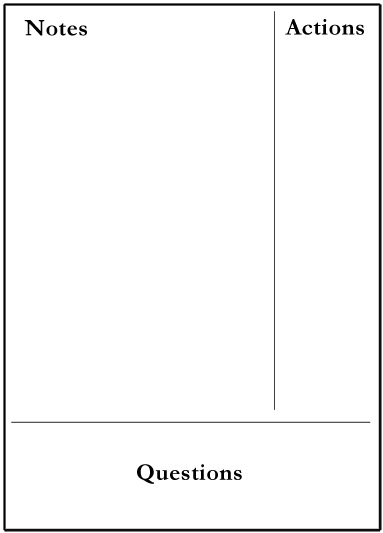Over the years I've earned a reputation as a ferverent, unrepentent note taker. I write notes about everything, scribbling stuff in an artist's sketch pad, typing madly in a text file or more recently thumbing myself reminders into my iOS-device. In meetings I'm constantly writing things down, summarizing discussions, making note of key points.
I'm not sure what it is, maybe it's because I don't trust my brain to remember, or maybe because it *helps* me remember or it's because I'm detail oriented. I do know that it helps me accurately hold the entire architecture of whatever it is I'm working on in my head, which makes it a lot easier to make informed decisions and weigh the implications of choices later on.
I thought I'd share a few tips 'n tricks about how I take notes, maybe you'll find something useful...
Medium: Analog or Digital?
I've seen a few note taking apps running on tablet computers, stuff from simple text editors to mind-mapping tools. For me it depends on what I'm doing. If I'm going into a meeting where I'm seeking some answers to some specific questions, I'll usually just have a text file open on my laptop with the questions or key objectives of the meeting and just type things in. If I'm there to listen to a client or someone else present or lecture, then I prefer paper.
My handwriting can be a bit messy, especially if I'm working really fast, but paper allows me to branch off in tangents, draw pictures and flow charts. I'm not limited to how I want to record my notes and layout the page, I just draw it and it happens. It allows for a more non-linear thinking style.
On the other hand, digital is way better for indexing and searching, and if you have terrible hand writing you might get into trouble later when you can't read something important.
I usually end up somewhere down the middle: recording notes on paper with a certain system, and then later digitizing the key points from those notes into a text file.
Notes on Paper: The Behance Action Method
When I'm making notes on paper, I have a system of laying out the page, some of which was inspired/stolen from Behance's Action Method, in particular their paper products. I carve up my page into 3 sections like this:

The Notes area is for, uh, notes obviously. Following Behance's lead, the right column is for Actions, todo items. As you write out notes, you add the stuff that you need to take care of in the right column, along side the notes in the left that they pretain to, so if you need a context for the action you need to take, it's right there. After the meeting, you just need to look at that column to figure out what you're responsible for.
The Questions area at the bottom is something I came up with. I found that during meetings, someone would be in the middle of explaining something or hashing out an idea. I'd have my questions and counter arguements but rather than break their flow, I now write these down into the bottom area and wait for them to finish. Then as I go through each question, I scratch it off, or make a note about the answer and connect it with the question by drawing an arrow.
The question area could also be used as a "parking lot", features or requests or ideas that won't make the cut for now, but maybe you can loop back to them at a later date.
Using symbols and notation markings
I sing in a choir in my free time, and something that we're always doing is marking up our scores in order to draw attention to something or make a change that the director wants. Sometimes we're just making additional musical notations, but sometimes I'm also writing in helpful cues like when I should look up because the director changes tempo, or where a good place to breath or turn the page is, or how I always sing this one note flat, and I need an arrow upwards to remind me it's higher than I think.
I do something similar for notes, using symbols to mark them up, to draw my eye to key things, or to help me sweep through the notes for particular kinds of informtion.
dash "-": just a generic bullet point note
plus "+": action item for me
plus "+" and checkmark : an action item I completed
equals "=": action item for somebody else, usually the client
star: key point
big giant star: *really important* key point
I probably need to come up with a unique symbol for "parking lot" items too.
Outlining
This is simply using headers, sometimes with underlines or horizontal rules, to help demarkate big ideas and topics into their own buckets, and then add points and sub-headers below that until the we're done talking about the topic. Makes it easy to find stuff in your notes later.
I also use numbers for steps in a plan or scenario or use case.
Clean up
At the end of the meeting, it's always a good idea to review what you actually wrote soon after, if not immediately. Chances are you left words out, spelt things wrong or didn't complete sentences. While it's still fresh in your head or people are nearby to ask questions of, flesh out those notes so that there are no errors and that they're complete.
You may also take the extra step of digitizing them/typing them out, but that's up to you. Most of the time I'm writing notes because I'm collecting requirements, so it's all going to go into some kind of document anyways.
Got any of your own tips? I'd love to hear about them in the comments.
Comments
Great post!
I always wondered what you were scribbling in all those meetings. Really cool to see your methodology.